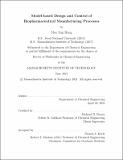Model-based Design and Control of Biopharmaceutical Manufacturing Processes
Author(s)
Hong, Moo Sun
DownloadThesis PDF (25.43Mb)
Advisor
Braatz, Richard D.
Terms of use
Metadata
Show full item recordAbstract
Biopharmaceuticals are products derived from biological organisms for treating or preventing diseases. The global sales of biopharmaceuticals have continually increased for many years and will continue to increase, as the pipeline of product candidates continues to grow. Recent trends in biopharmaceutical manufacturing provide opportunities for process systems engineering to make major advances in biomanufacturing: (1) process analytical technology (PAT) is providing on-line measurements of critical quality attributes (CQAs) for constructing first-principles and data-based models of each unit operation and enable advanced control, (2) a transition from batch to continuous operation provides process control needs to handle the propagation of impurities and other disturbances caused by tight integration of unit operations, and (3) the invention of new designs for downstream processes is creating new processes to control. These trends ultimately lead biomanufacturing to digital manufacturing, which is an integrated approach to manufacturing centered around a computer system.
To address the challenges associated with the recent trends, this thesis applies modern system engineering tools to develop advanced biomanufacturing systems. For the upstream process, the thesis constructs mathematical models and optimal control methods for multiple bioreactor configurations including microbioreactor systems and stirred-tank bioreactors.
Microbioreactors are a promising technology to accelerate biologic drug development, but can have localized dissolved oxygen (DO) concentrations that are damaging to the cells. To address this problem, the thesis derives analysis, estimation, and control methods that improve understanding and spatiotemporal control of DO concentration in these systems.
Macroscopic models can produce useful predictions of bioreactor operations while being suitable for parameter estimation and real-time model predictive control. The thesis constructs an extensive macroscopic bioreactor model for recombinant protein producing Pichia pastoris in defined medium, which enables the comprehensive understanding of cellular metabolism and optimization of bioreactor operations.
For the downstream process, the thesis designs and implements laboratory unit operation systems for protein crystallization and continuous viral inactivation, which are optimally designed and controlled based on developed mathematical models.
Although crystallization is a promising non-chromatography separation method, research and development are needed to develop technology effective for most therapeutic proteins. The thesis develops a systematic approach to the design and control of protein crystallization from micro-scale based on first-principles models. First, preliminary experimental data from the literature are analyzed to obtain feasible crystallization conditions and lower bounds on the crystallization rates. Then a droplet-based evaporative system is developed to evaluate candidate crystallization conditions and estimate crystallization kinetics using only a minimum quantity of protein. The estimated crystallization kinetics provide information required for the model-based optimal scale-up to production scale.
Batch low-pH hold is a common processing step to inactivate enveloped viruses for biologics derived from mammalian sources. Control challenges with adapting batch low-pH hold to continuous processing have not been addressed. The thesis develops a low-cost column-based continuous-flow viral inactivation system constructed with off-the- shelf components to provide tight control of critical process parameters, operating pH and residence time distribution. This work provides tools for the design and operation of continuous viral inactivation systems in service of increasing productivity, improving product quality, and enhancing patient safety.
Date issued
2021-06Department
Massachusetts Institute of Technology. Department of Chemical EngineeringPublisher
Massachusetts Institute of Technology